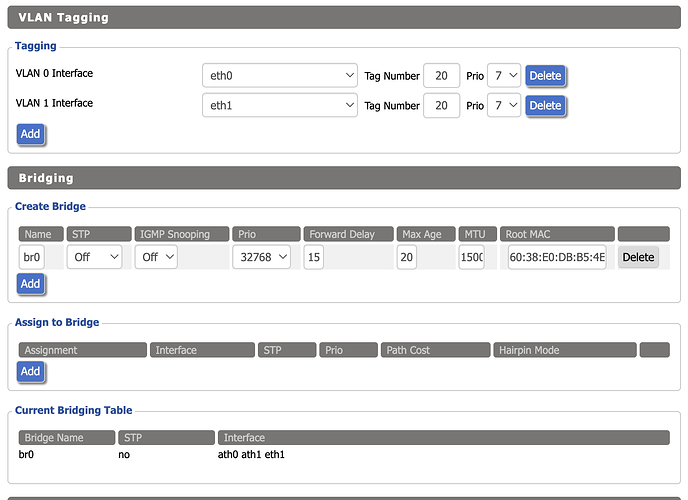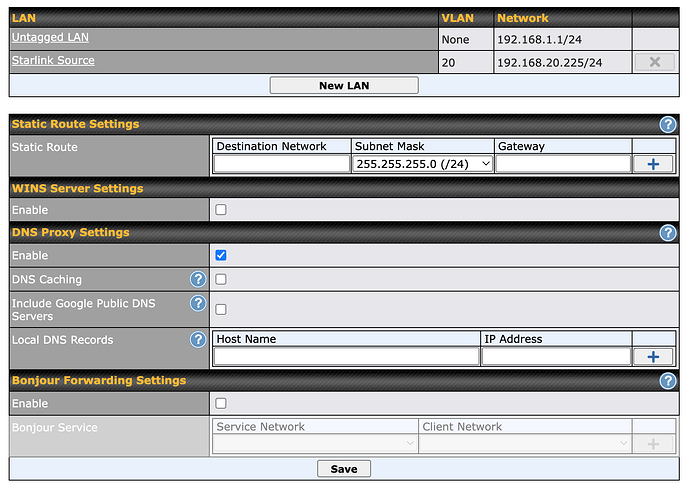I’m wondering if someone might be able to give me some help uniting two buildings for mixed purposes without burying another CAT6 Cable.
Situation: Main building has DSL WAN device and connected to Peplink Balance20 WAN2 for backup internet. Remote building is sending Starlink public IP to main building on a single CAT6 going to WAN1 on Balance20. Both internet connections working well for main building.
I have client devices in the remote building that I would like to both access the internet and the local area network in the main building.
Is it possible to setup the WAN1 port to both balance the Starlink connection AND act as a LAN port, maybe adding a router in the remote building that can do a VLAN? At the moment I have the Starlink router in bridge mode with ethernet adapter, so the dishy itself is providing StarLink’s public IP.
I have done some reading on setting up VLANs with tagged traffic. I’m wondering if I might be able to get a bit of a detailed step by step with additional equipment I might need in the remote building, and how to set up traffic tagging if any of this is possible.
Thank you in advance to whoever might be able to solve this for me.
Yes you can, in a few ways.
-
Use the Synergy controller in 8.3.0, on supported hardware not the older ones) and have another Peplink in the other building that is managed by the primary one, as a “remote wan port”.
-
Use the “WAN on VLAN”, by licence on some models, and a number of the prime care models get one free in 8.3.0
-
Decide on a vlan for the Starlink, and bring it over from the other building in a VLAN. Create that VLAN on the Peplink as well, and set that WAN port on the Peplink to use that VLAN for that WAN. Then plug the WAN port into a free LAN port on the Peplink, so the Starlink VLAN comes through from the switch where the Starlink is plugged in, trunked to the Peplink & through the Peplink internal switch to the WAN port
2 Likes
Thank you Bryn, I think I can fly with this. I appreciate your time and clarity of explanation. I’m going to try option 3, as I have an older Linksys router with DD-WRT that I should be able to use in the remote building that can do VLAN. I had no idea you could plug a router into itself for a solution. Very interesting.
It’s a bit of a “cheat”, but as long as the VLAN tags are all set right it works…
Understanding it conceptually is a bit easier if you think about the Peplink as say 3 devices instead of 1, that happen to be in the same box.
There is the router/SDWAN smart bit, with a couple of WAN interfaces and a LAN interface. Then there is a switch, connected to that LAN port & with 4x downstream LAN ports (or however many the specific model has) and then perhaps also a wireless access point.
So then putting that together, you can see how the Starlink WAN VLAN can be brought through the external switches, the internal switch and then to the WAN port. Some caveats apply in some circumstances for things like STP etc.
1 Like
Hi Bryn,
You’ve been so kind to help, but it seems like for this, I am way over my head. I can’t seem to be confident with the settings on either end.
The DDWRT router in the remote building has Starlink connected to the WAN port, which i believe is “eth0”. It is receiving the public IP and I have connectivity in a standard NAT setup. I chose to put that router at 192.168.20.1 and disable DNS Server, or should I manually assign a static IP in the 192.168.1.x subnet, as that is what the Peplink is set for? I would prefer the Peplink give IP addresses out to all clients back at the barn building, and have DDWRT set up just as a bridge and bringing VLAN20 (Starlink WAN) back to peplink.
I have the trunk connected to eth1 on DDWRT, which i believe is physical port 1, and into port 3 on peplink. Then port 4 on peplink is looped to WAN port on same peplink. If I attach photos of both relevant router pages, can you correct my mistakes and let me know what to change? I never really moved beyond basic network understanding.
If the Starlink is only used by the Peplink, you don’t need the router in the other building, but you do need a VLAN aware switch.
This is a sample off the layout:
1 Like
Actually, that picture is for WAN as VLAN… if you aren’t using WAN as VLAN, then if you have a VLAN aware switch in both buildings:
or if you only have a VLAN aware switch in the remote building:
1 Like
Hi Bryn,
Yes, I only have one VLAN aware switch (router setup as gateway) in the remote building. The only reason Starlink is there is because it is several hundred feet away from tree obstacles. I do really like your idea to loop the connection from the switch on the peplink switch portion to the WAN on the same router. I have decided to flash the gateway router in the remote building to an OpenVPN OS. It makes a little more sense to me and gives me a clear picture of my ports with their assignments.
The diagram you sent me makes good sense, but I can’t seem to figure out the port configuration in both router softwares, and setup maybe the proper bridging to assign the VLAN to make it’s way to the WAN1 port on the Peplink, while still allowing local traffic back and forth with the two buildings. With all of this, I still need to do load balancing with WAN2 (DSL) in the main building, and have balanced internet access brought back out to the remote building where the Starlink comes in. The OpenVPN router will be providing load balanced wifi at the remote building, not just Starlink. I am hoping this is possible. Can you give me some detailed info on how I configure all of the ports with tagging and bridging? I’m assuming to make the OpenVPN router just a glorified switch, I disable the WAN and DHCP, but I am still left with a bridging and tagging setup scenario that is going over my head in the software. I believe I can learn and be proficient at this, but I’m a bit stuck. Thanks again for the diagrams of the physical connections.
What you have there is essentially correct, with the exception of the Starlink connecting to the “wan” port of the openWRT device. It should connect to a LAN port that is untagged in the “WAN” vlan.
1 Like









